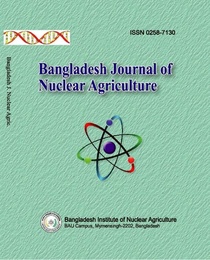BINALEBU-2: A HIGH YIELDING, YEAR-ROUND, SCENTED AND SEEDLESS VARIETY OF LEMON
Abstract
Citrus fruits, especially Lemon (Citrus limon) belonging to the family Rutaceae are the most important nutritional fruits in Bangladesh. Twenty local and exotic lemon germplasm were collected from home and abroad. The germplasm CL-1 and CL-2 were collected from Darziling, India. The germplasm was evaluated during 2016-17, 2017-18 and 2018-19 at Mymensingh and Tangail and the experiments were carried out following randomized complete design with three replications. Binalebu-1 was used as a check variety in the experiments. Data were recorded on plant height, number of fruits per plant, fruit length, fruit breadth, individual fruit weight, fruit yield per plant, vitamin C and juice contents, and seeds per fruit were recorded. Moreover, reactions to major diseases and insect-pests infestation were also recorded. From the results it was observed that CL-1 was found to be superior to other exotic genotypes and to check variety Binalebu-1. During 2016-17, 2017-18 & 2018-19 at Mymensingh, the highest fruit yield plant-1 (25.45, 32.11 and 40.36 kg), vitamin C (30.11, 29.78 and 29.65 mg 100 g-1), plant height (162.55, 22.41 and 265.23 cm), fruit length (7.72, 7.51 and 7.50 cm), number of fruits plant-1 (172.3, 221.1 and 281.77), juice content fruit-1 (55.25%, 54.11% and 54.31%) and the lowest number of seeds fruit-1 (4, 4 and 4.1) was recorded from CL-1 in all the three consecutive year trials. Similarly at Tangail the highest fruit yield plant-1 (24.94, 31.36, and 35.41 kg), vitamin C (28.44, 30.12 and 30.15 mg 100 g-1), plant height (160.2, 220.9 and 260.54 cm), fruit length (7.66, 7.56 and 7.48 cm), number of fruits plant-1 (170, 223 and 261), juice content fruit-1 (52%, 52% and 53%) and lowest number of seeds fruit-1 (4.1, 4.6 and 5) was recorded from CL-1, which was the highest compared to CL-2 and Binalebu-1 at both locations. The lowest fruit yield plant-1 and vitamin C, highest number of seeds fruit-1 observed at CL-2 at both of Mymensingh and Tangail. Considering the better performance of fruit yield, vitamin C content, juice content and less number of seeds compare to CL-2 and Binalebu-1, CL-1 genotype was selected as a new variety naming Binalebu-2 to grow commercially all over Bangladesh.
References
Abdullah, H.M., Rahman, M.M. 2015. Initiating rainwater harvest technology for climate change induced drought resilient agriculture: scopes and challenges in Bangladesh. Journal of Agriculture and Environment for International Development. 109:189-208.
Al-Mouei, R. and Choumane, W. 2014. Physiochemical Juice Characteristics of Various Citrus Species in Syria, Anuual Report. Pp. l-14.
BBS. 2020. Statistical Pocket Book of Bangladesh, 2020. Bangladesh Bureau of Statistics, Planning Division, Ministry of Planning, Government of the People's Republic of Bangladesh, Dhaka. p. 221.
Caruso, M., Smith, M.W., Froelicher, Y., Russo, G., and Gmitter, F.G. Jr. 2020. “Traditional breeding,” in The Genus Citrus, 1st edition. Eds. M. Talon, M. Caruso and F. G. Gmitter (Cambridge, UK: Elsevier), 129–148.
Cirmi, S., Ferlazzo, N., Lombardo, G., Maugeri, A., Calapai, G., Gangemi, S., et al. (2016). Chemopreventive agents and inhibitors of cancer hallmarks: may citrus offer new perspectives? Nutrients 8, 698. doi: 10.3390/nu8110698.
Fallahi, E., Rodney, D.R. and Mousavi, Z. 1990. Growth, yield and fruit quality of eight lemon cultivars in Arizona. J. Amer. Soc. Hort. Sci., 115: 6-8.
Gomez, K.A. and Gomez, A.A. 1984. Statistical Procedures for Agricultural Research. John Wiley and Sons, USA.
Hossian M, Bhuyan M, Islam K. 2011. Modern Techniques of Fruit Production. Gazipur, Bangladesh: Horticulture Research Centre.
Kayesh, E., Das, S., Rajib, M.M.R. & Islam, M.M. 2017. Morphological characteristics and fruit quality of selected lemon genotypes. Ann. Bangladesh Agric. 21 (1 & 2): lll-116
Liu, Y., Heying, E., and Tanumihardjo, S.A. 2012. History, global distribution, and nutritional importance of citrus fruits. Compr. Rev. Food Sci. Food Saf. 11, 530–545. doi: 10.1111/j.1541-4337.2012.00201.x
Ma, G., Zhang, L., Sugiura, M., and Kato, M. 2020. “Citrus and health,” in The Genus Citrus, 1st edition. Eds. M., Talon, M. Caruso and F. G. Gmitter (Cambridge, UK: Elsevier), 495–511.
Mamun, M.A.A., Siddquie, N.A., Reyad-ul-ferdous, M., Sayem, A.S.M., Hossain, M.S. 2015. Effective nutritional value of year-round vegetable production and quick growing fruit trees in homestead at agro ecological zone eleven in Bangladesh for improvement of the health of rural people. World Journal of Pharmaceutical Sciences 4(12):1626-1637.
Marin, F.R., Soler-Rivas, C., Benavente-Garcia, O., Castillo, J., and Perez-Alvarez, J.A. 2007. By-products from different citrus processes as a source of customized functional fibres. Food Chem. 100, 736–741. doi: 10.1016/j.foodchem.2005.04.040.
Nielsen, H. 2000. Food and nutrient intake among females in rural Bangladesh. Master’s in human nutrition Dissertation, Research Department of Human Nutrition, The Royal Veterinary and Agricultural University, Copenhagen, Denmark.
Prasad, M.B., Singh, R.S., Rekha, A. and Chand, R. 1997. Evaluation of lemon cultivars and acid lime lemon hybrids for resistance to Xanthomonas campestris pvcitri. Scientia Hort., 71: 367-372
Rahman M, Rahman J. 2014. Medicinal Value and Nutrient Status of Indigenous Fruits in Bangladesh. Nova Journal of Medical and Biological Sciences 3(4), 1-9.
Ranganna S. 1991. Hand Book of Analysis and Quality Control for Fruit and Vegetable Products. Tata McGraw-Hill Publishing Co. Ltd., New Delhi, India. 1112p.
Sfgate, 2017. Do Lemons Provide Vitamin C Like Oranges Do? http://healthyeating.sfgate.com/ lemonsprovide-vitamin-c-like-oranges-do-3508.html, access on April 9, 2017.
Shrestha, R.L., Dhakal, D.D., Gautum, D.M., Paudya, K.P. and Shrestha, S. 2014. Variation of physiochemical components of acid lime (Citrus auranffilia Single) Fruits at different sides of the tree in Nepal. Amer. J. Plant Sci. 3: 1688-1692.
Soeranto, H. 2011. Plant breeding with mutation technique (in Indonesian). Indonesian Center for Isotopes and Radiation Technology Research and Development. Jakarta: National Nuclear Energy Agency of Indonesia.
Ting, S.V. 1980 “Nutrients and Nutrition of Citrus Fruits,” in Citrus nutrition and quality. Eds. S. NagyJohn and A. Attaway (Washington, DC. USA: American chemical society), 3–24. doi: 10.1021/bk-1980-0143.ch001.
Umar, U.U., S.G. Ado, D.A. Aba and S.M. Bugaje. 2015. Studies on genetic variability in maize (Zea mays L.) under stress and non-stress environmental conditions. Int. J. Agron. Agril. Res., 7: 70-77.
-
Download



